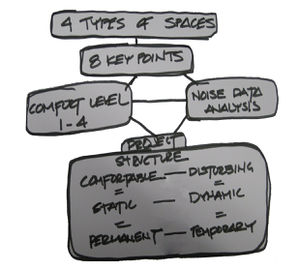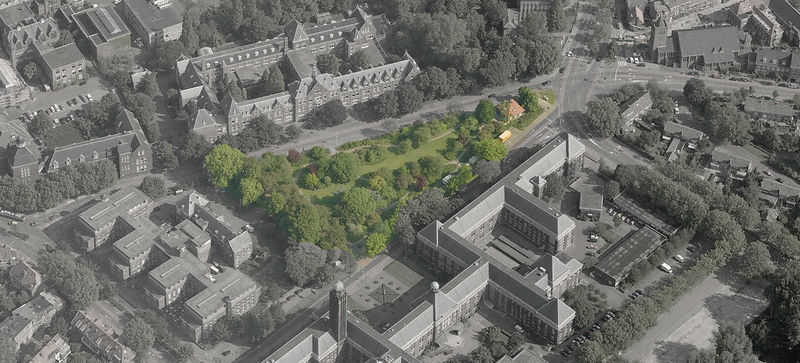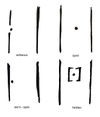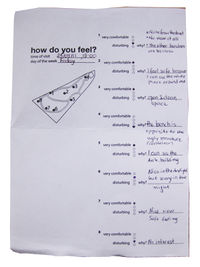atom03:Project
(→CLIENT) |
|||
| (17 intermediate revisions by 2 users not shown) | |||
| Line 1: | Line 1: | ||
| − | '''NOISE''' | + | =='''NOISE'''== |
| − | From the beginning of | + | From the beginning of our site analysis, we found the high intensity of sound to be an important element. This is a consequence of the surrounding streets and their constant traffic; this made the area a crossing (temporary)space rather than congregational, as the site was originally intended. |
| − | In order to integrate the site back to area and bring the community closer, we want to explore the relationship between architecture and sound, how a building reacts to sound, and how sound could be altered. We think sound and sound manipulation is a powerful tool to generate space and | + | In order to integrate the site back to area, and bring the community closer, we want to explore the relationship between architecture and sound, how a building reacts to sound, and how sound could be altered. We think sound and sound manipulation is a powerful tool to generate space, and also find fascinating by the effect of sound in people, and how it can transform someone's experience. |
| − | '''PROBLEM | + | =='''PROBLEM AND ANALYSIS'''== |
| − | ''' | + | |
| − | + | ||
| − | + | ||
| − | + | ||
| − | + | ||
| − | + | ||
| − | + | ||
| − | + | ||
| − | + | ||
| − | + | ||
| − | + | ||
| − | + | ||
| − | + | ||
| + | By means of [[atom03: personal observation|observation]] and [[atom03: interviews|interviews with locals]],we confirmed that [[atom03: noise|noise]], prevents users from fully enjoying the area. It is also obvious that the park is lacking programmatic definition, it could be considered as an area to relax but the sound levels do not allow this. | ||
| + | Access to the park is difficult, as the [[atom03: entrances|entrances]] are uninviting and are not [[atom03: strategically|strategically]] placed. This results in many inhabitants, students and staff refraining from visiting the park, therefore safety becomes an issue, hardly anybody is keeping an eye on the park, turning the issue into a cycle. | ||
| Line 31: | Line 20: | ||
| − | [[Image:Atom3spaces.jpg|thumb|right |100px|categories ]]The De Vries van Heystplantsoen site has a strong natural character. Unlike its surroundings, it | + | [[Image:Atom3spaces.jpg|thumb|right |100px|categories ]]The De Vries van Heystplantsoen site has a strong natural character. Unlike its surroundings, it is a rare and powerful urban typology in Delft. It is an isolated site and its [[atom03: introversion|introversion]] is stressed by the plantation barrier on the periphery. However once inside, we experienced a [[atom03: selected areas|variety of areas]] with a distinctive character, and categorized them based on their relationship with the borders. |
| + | =='''CLIENT'''== | ||
| + | Our client is a local organization TU-Noord. During one of our interviews, we were told that TU-Noord had the mission to preserve the majority of buildings in the area of the TU Delft north campus area. Their mission is for the neighborhood and maintain the environment pleasantly liveable. TU-Noord also has a workgroup which discusses about the characteristics of the park (De Vries van Heystplantsoen) and its surroundings. The fact that they have such a workgroup made us curious about the TU-Noord as an organization. Therefore we arranged an [[atom03: interview|interview]] with Erik van Hunnik (chairman of TU-Noord) in order to get to know more about what they're aiming for as an organization, what their goals are, but also about their ideas concerning the park. | ||
| + | =='''CHALLENGE'''== | ||
| + | Our challenge is to integrate the site with the surroundings, attract visitors and generate varied activity by [[atom03: sound manipulation |manipulation of sound]]. | ||
| + | =='''CONCEPT'''== | ||
| + | Any design decision can manipulate sound, but interesting and controlled sound experiences result from interesting spaces. Our intervention is to create a variety of spaces that can manipulate sound, these variety of areas is reminiscent of the one seen in the current site, but should be more memorable by means of a contrasting sequence of sound/space experiences. | ||
| + | =='''PROCESS'''== | ||
<br style="clear: both; height: 0; line-height: 0; font-size: px; /*for IE*/"/> | <br style="clear: both; height: 0; line-height: 0; font-size: px; /*for IE*/"/> | ||
| Line 49: | Line 45: | ||
'''Step 1 | '''Step 1 | ||
''' | ''' | ||
| − | + | To understand the current relation between sound and space, we first have to define which areas are problematic regarding the sound levels and their effect on comfort levels. In order to obtain these results, we organized a comfort/disturbance survey and sound data analysis. The [[atom03:questionnaire|questionnaire]] has 1 main question about disturbance and comfort, participants answer this question at the 8 mentioned keypoints of the site. The [[atom03:results 2|results]] will help identify why these areas are really problematic. | |
[[File:Atom3surveyex2.jpg|200px]] | [[File:Atom3surveyex2.jpg|200px]] | ||
| − | Secondly, with the help of a TU Delft acoustics expert we | + | Secondly, with the help of a TU Delft acoustics expert we measured sound pressure levels for a week, in specific time periods at the same 8 points. The objective of this study is to obtain quantitative data regarding sound levels at these points during different times and during different circumstances. These are the [[atom03: results |results]]. |
</div> | </div> | ||
| Line 60: | Line 56: | ||
'''Step 2 | '''Step 2 | ||
''' | ''' | ||
| − | After having both the qualitative and quantitative results, | + | After having both the qualitative and quantitative results, it is possible to cross reference the analysis and have a link between sound to spatial conditions. |
[[File:Atom3process.jpg|300px]] | [[File:Atom3process.jpg|300px]] | ||
| Line 72: | Line 68: | ||
[[File:Motion1.jpg|300px]] | [[File:Motion1.jpg|300px]] | ||
| + | ''' | ||
| + | Initial site gesture :''' | ||
| − | As the stingray redirects water '''(medium)''' to achieve motion, our project will simulate this movement behaviour by redirecting air '''(medium)''' as a manipulative element of sound levels. This is possible by undulations on the surface of the ground controlling air/sound paths. | + | As the stingray redirects water '''(medium)''' to achieve motion, our project will simulate this movement behaviour by redirecting air '''(medium)''' as a manipulative element of sound levels. This is possible by undulations and deformations on the site surface of the ground and introduced surfaces - controlling air/sound paths. |
| + | |||
| + | As a reaction to these deformations, spaces with unique characteristics will be generated at ground and underground level; these spaces will be categorized from '''static / comfortable / permanent''' to '''dynamic / disturbing / temporary''' with intermediate states as transitional spaces; in other words, we want to create static spaces with a permanent function, these functions will be situated at "comfortable" places within the site. To understand factors affecting levels of comfort, we will draw [[atom03: withdrawn|conclusions]] from the qualitative survey (questionnaire). | ||
| + | These static spaces will be linked to dynamic spaces with temporary functions situated at places which are less "comfortable". By means of linking static and dynamic spaces a contrasting sequence will arise. | ||
| + | |||
| + | ''' | ||
| + | |||
| + | Initial connection to surroundings:''' | ||
| + | |||
| + | closing of juliannalaan - connection to pedestrian paths / manipulation of pedestrian paths. | ||
| − | |||
</div> | </div> | ||
| Line 90: | Line 96: | ||
| − | + | =====[[atom03:references|'''REFERENCES''']]===== | |
| Line 97: | Line 103: | ||
| − | |||
| − | |||
| − | |||
Latest revision as of 11:00, 11 October 2011
Contents |
NOISE
From the beginning of our site analysis, we found the high intensity of sound to be an important element. This is a consequence of the surrounding streets and their constant traffic; this made the area a crossing (temporary)space rather than congregational, as the site was originally intended. In order to integrate the site back to area, and bring the community closer, we want to explore the relationship between architecture and sound, how a building reacts to sound, and how sound could be altered. We think sound and sound manipulation is a powerful tool to generate space, and also find fascinating by the effect of sound in people, and how it can transform someone's experience.
PROBLEM AND ANALYSIS
By means of observation and interviews with locals,we confirmed that noise, prevents users from fully enjoying the area. It is also obvious that the park is lacking programmatic definition, it could be considered as an area to relax but the sound levels do not allow this.
Access to the park is difficult, as the entrances are uninviting and are not strategically placed. This results in many inhabitants, students and staff refraining from visiting the park, therefore safety becomes an issue, hardly anybody is keeping an eye on the park, turning the issue into a cycle.
CLIENT
Our client is a local organization TU-Noord. During one of our interviews, we were told that TU-Noord had the mission to preserve the majority of buildings in the area of the TU Delft north campus area. Their mission is for the neighborhood and maintain the environment pleasantly liveable. TU-Noord also has a workgroup which discusses about the characteristics of the park (De Vries van Heystplantsoen) and its surroundings. The fact that they have such a workgroup made us curious about the TU-Noord as an organization. Therefore we arranged an interview with Erik van Hunnik (chairman of TU-Noord) in order to get to know more about what they're aiming for as an organization, what their goals are, but also about their ideas concerning the park.
CHALLENGE
Our challenge is to integrate the site with the surroundings, attract visitors and generate varied activity by manipulation of sound.
CONCEPT
Any design decision can manipulate sound, but interesting and controlled sound experiences result from interesting spaces. Our intervention is to create a variety of spaces that can manipulate sound, these variety of areas is reminiscent of the one seen in the current site, but should be more memorable by means of a contrasting sequence of sound/space experiences.
PROCESS
Step 1 To understand the current relation between sound and space, we first have to define which areas are problematic regarding the sound levels and their effect on comfort levels. In order to obtain these results, we organized a comfort/disturbance survey and sound data analysis. The questionnaire has 1 main question about disturbance and comfort, participants answer this question at the 8 mentioned keypoints of the site. The results will help identify why these areas are really problematic.
Secondly, with the help of a TU Delft acoustics expert we measured sound pressure levels for a week, in specific time periods at the same 8 points. The objective of this study is to obtain quantitative data regarding sound levels at these points during different times and during different circumstances. These are the results.
Step 2
After having both the qualitative and quantitative results, it is possible to cross reference the analysis and have a link between sound to spatial conditions.

Step 3
As the stingray redirects water (medium) to achieve motion, our project will simulate this movement behaviour by redirecting air (medium) as a manipulative element of sound levels. This is possible by undulations and deformations on the site surface of the ground and introduced surfaces - controlling air/sound paths.
As a reaction to these deformations, spaces with unique characteristics will be generated at ground and underground level; these spaces will be categorized from static / comfortable / permanent to dynamic / disturbing / temporary with intermediate states as transitional spaces; in other words, we want to create static spaces with a permanent function, these functions will be situated at "comfortable" places within the site. To understand factors affecting levels of comfort, we will draw conclusions from the qualitative survey (questionnaire). These static spaces will be linked to dynamic spaces with temporary functions situated at places which are less "comfortable". By means of linking static and dynamic spaces a contrasting sequence will arise.
Initial connection to surroundings:
closing of juliannalaan - connection to pedestrian paths / manipulation of pedestrian paths.
REFERENCES



